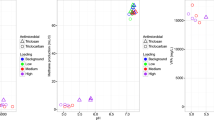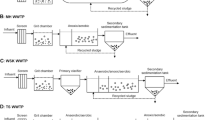Abstract
Anaerobic processes are widely used for treating high-strength organic wastewater. Understanding the ecological patterns of the microorganisms involved and the effect of environmental factors on microbial community are important to manage the performance of anaerobic processes. Microbial communities of 12 anaerobic sludge samples acclimated under different environmental conditions were investigated. Genera detected from these anaerobic sludge samples generally presented three distribution patterns: frequently detected with high abundance, frequently detected with low abundance and occasionally detected with permanently low abundance. The type of feed stock was one of the most important process parameters affecting the shape of microbial community (e.g., Syntrophus, Methylomonas and Methylobacillus). Dye wastewater (Bacteroides) and the supplement of conductive materials (genus T78) were also found to shape the microbial community. Some syntrophic bacteria and methanogens were rare in many anaerobic samples. However, correlation analysis suggested that rare genera are potential syntrophic partners and are responsible for syntrophic methanogenesis.





Similar content being viewed by others
References
Albuquerque MG, Carvalho G, Kragelund C et al (2013) Link between microbial composition and carbon substrate-uptake preferences in a PHA-storing community. ISME J 7:1–12
Bell G (2000) The distribution of abundance in neutral communities. Am Nat 155:606–617
Cervantes FJ, Dos Santos AB (2011) Reduction of azo dyes by anaerobic bacteria: microbiological and biochemical aspects. Rev Environ Sci Biol 10:125–137
Chen S, Cheng H, Wyckoff KN et al (2016) Linkages of Firmicutes and Bacteroidetes populations to methanogenic process performance. Rev Environ Sci Biol 43:771–781
de Bok FA, Harmsen HJ, Plugge CM et al (2005) The first true obligately syntrophic propionate-oxidizing bacterium, Pelotomaculum schinkii sp. nov., co-cultured with Methanospirillum hungatei, and emended description of the genus Pelotomaculum. Int J Syst Evol Microbiol 55:1697–1703
Dridi B, Fardeau ML, Ollivier B et al (2012) Methanomassiliicoccus luminyensis gen. nov., sp. nov., a methanogenic archaeon isolated from human faeces. Int J Syst Evol Microbiol 62:1902–1907
Fernández-Gomez B, Richter M, Schuler M et al (2013) Ecology of marine Bacteroidetes: a comparative genomics approach. ISME J 7:1026–1037
Galand PE, Casamayor EO, Kirchman DL (2009) Ecology of the rare microbial biosphere of the Arctic Ocean. Proc Natl Acad Sci USA 106:22427–22432
Hoefman S, van der Ha D, Boon N et al (2014) Customized media based on miniaturized screening improve growth rate and cell yield of methane-oxidizing bacteria of the genus Methylomonas. Antonie Van Leeuwenhoek 105:353–366
Hoehler TM, Alperin MJ, Albert DB et al (2001) Apparent minimum free energy requirements for methanogenic Archaea and sulfate-reducing bacteria in an anoxic marine sediment. FEMS Microbiol Ecol 38:33–41
Jetten MS, Stams AJ, Zehnder AJ (1992) Methanogenesis from acetate: a comparison of the acetate metabolism in Methanothrix soehngenii and Methanosarcina spp. FEMS Microbiol Lett 88:181–197
Kampmann K, Ratering S, Kramer I et al (2012) Unexpected stability of Bacteroidetes and Firmicutes communities in laboratory biogas reactors fed with different defined substrates. Appl Environ Microbiol 78:2106–2119
Kim TS, Jeong JY, Wells GF (2013) General and rare bacterial taxa demonstrating different temporal dynamic patterns in an activated sludge bioreactor. Appl Microbiol Biotechnol 97:1755–1765
Kindaichi T, Nierychlo M, Kragelund C et al (2013) High and stable substrate specificities of microorganisms in enhanced biological phosphorus removal plants. Environ Microbiol 15:1821–1831
Kushkevych I, Kováč J, Vítězová M et al (2018) The diversity of sulfate-reducing bacteria in the seven bioreactors. Arch Microbiol 200:1–6
Lovley DR (2011) Reach out and touch someone: potential impact of DIET (direct interspecies energy transfer) on anaerobic biogeochemistry, bioremediation, and bioenergy. Rev Environ Sci Biotechnol 10:101–105
McInerney MJ, Struchtemeyer CG, Sieber JR (2008) Physiology, ecology, phylogeny, and genomics of microorganisms capable of syntrophic metabolism. Ann N Y Acad Sci 1125:58–72
McInerney MJ, Sieber JR, Gunsalus RP (2009) Syntrophy in anaerobic global carbon cycles. Curr Opin Biotechnol 20:623–632
Meerburg FA, Vlaeminck SE, Roume H (2016) High-rate activated sludge communities have a distinctly different structure compared to low-rate sludge communities, and are less sensitive towards environmental and operational variables. Water Res 100:137–145
Muller N, Schleheck D, Schink B (2009) Involvement of NADH:acceptor oxidoreductase and butyryl coenzyme A dehydrogenase in reversed electron transport during syntrophic butyrate oxidation by Syntrophomonas wolfei. J Bacteriol 191:6167–6177
Naumann E, Hippe H, Gottschalk G (1983) Betaine: new oxidant in the Stickland reaction and methanogenesis from betaine and l-alanine by a Clostridium sporogenes-Methanosarcina barkeri coculture. Appl Enivron Microbiol 45:474–483
Park Y, Cho H, Yu J et al (2017) Response of microbial community structure to pre-acclimation strategies in microbial fuel cells for domestic wastewater treatment. Bioresour Technol 233:176–183
Pedrós-Alió C (2006) Marine microbial diversity: can it be determined? Trends Microbiol 14:257–263
Ranawat P, Rawat S (2017) Stress response physiology of thermophiles. Arch Microbiol 199:391–414
Rotaru AE, Shrestha PM, Liu F et al (2014) A new model for electron flow during anaerobic digestion: direct interspecies electron transfer to Methanosaeta for the reduction of carbon dioxide to methane. Energ Environ Sci 7:408–415
Rui J, Li J, Zhang S et al (2015) The core populations and co-occurrence patterns of prokaryotic communities in household biogas digesters. Biotechnol Biofuels 8:158
Saunders AM, Albertsen M, Vollertsen J et al (2016) The activated sludge ecosystem contains a core community of abundant organisms. ISME J 10:11–20
Schnürer A, Schink B, Svensson BH (1996) Clostridium ultunense sp. nov., a mesophilic bacterium oxidizing acetate in syntrophic association with a hydrogenotrophic methanogenic bacterium. Int J Syst Evol Microbiol 46:1145–1152
van der Gast CJ, Whiteley AS, Thompson IP (2004) Temporal dynamics and degradation activity of an bacterial inoculum for treating waste metal-working fluid. Environ Microbiol 6:254–263
van der Gast CJ, Ager D, Lilley AK (2008) Temporal scaling of bacterial taxa is influenced by both stochastic and deterministic ecological factors. Environ Microbiol 10:1411–1418
Wallrabenstein C, Schink B (1994) Evidence of reversed electron transport in syntrophic butyrate or benzoate oxidation by Syntrophomonas wolfei and Syntrophus buswellii. Arch Microbiol 162:136–142
Wang Z, Yin Q, Gu M et al (2018) Enhanced azo dye Reactive Red 2 degradation in anaerobic reactors by dosing conductive material of ferroferric oxide. J Hazard Mater 357:226–234
Weisse T (2014) Ciliates and the rare biosphere-community ecology and population dynamics. J Eukaryot Microbiol 61:419–433
Welte C, Deppenmeier U (2014) Bioenergetics and anaerobic respiratory chains of aceticlastic methanogens. Biochim Biophys Acta Bioenerg 1837:1130–1147
Winter C, Bouvier T, Weinbauer MG (2010) Trade-offs between competition and defense specialists among unicellular planktonic organisms: the “killing the winner” hypothesis revisited. Microbiol Mol Biol Rev 74:42–57
Xing L, Yang S, Yin Q et al (2017) Effects of carbon source on methanogenic activities and pathways incorporating metagenomic analysis of microbial community. Bioresour Technol 224:982–988
Yachi S, Loreau M (1999) Biodiversity and ecosystem productivity in a fluctuating environment: the insurance hypothesis. Proc Natl Acad Sci USA 96:1463–1468
Yin Q, He K, Liu A et al (2017a) Enhanced system performance by dosing ferroferric oxide during the anaerobic treatment of tryptone-based high-strength wastewater. Appl Microbiol Biotechnol 101:3929–3939
Yin Q, Miao J, Li B et al (2017b) Enhancing electron transfer by ferroferric oxide during the anaerobic treatment of synthetic wastewater with mixed organic carbon. Int Biodeterior Biodegrad 119:104–110
Yin Q, Yang S, Wang Z et al (2018) Clarifying electron transfer and metagenomic analysis of microbial community in the methane production process with the addition of ferroferric oxide. Chem Eng J 333:216–225
Yordy JR, Weaver TL (1977) Methylobacillus: a new genus of obligately methylotrophic bacteria. Int J Syst Evol Microbiol 27:247–255
Yu K, Zhang T (2012) Metagenomic and metatranscriptomic analysis of microbial community structure and gene expression of activated sludge. PLoS One 7:e38183
Zeikus JG, Wolee RS (1972) Methanobacterium thermoautotrophicus sp. n., an anaerobic, autotrophic, extreme thermophile. J Bacteriol 109:707–713
Zhang K, Song L, Dong X (2010) Proteiniclasticum ruminis gen. nov., sp. nov., a strictly anaerobic proteolytic bacterium isolated from yak rumen. Int J Syst Evol Microbiol 60:2221–2225
Zhang T, Shao MF, Ye L (2012) 454 pyrosequencing reveals bacterial diversity of activated sludge from 14 sewage treatment plants. ISME J 6:1137–1147
Zhang W, Werner JJ, Agler MT et al (2014) Substrate type drives variation in reactor microbiomes of anaerobic digesters. Bioresour Technol 151:397–401
Zhu X, Kougias PG, Treu L et al (2017) Microbial community changes in methanogenic granules during the transition from mesophilic to thermophilic conditions. Appl Microbiol Biotechnol 101:1313–1322
Acknowledgements
This research was supported by the National Natural Science Foundation of China (51878371) and the Science and Technology Innovation Committee of Shenzhen Municipality (JCYJ20170817161106801). The authors would like to thank the reviewers for their careful reviews and useful suggestions.
Author information
Authors and Affiliations
Corresponding author
Additional information
Publisher’s Note
Springer Nature remains neutral with regard to jurisdictional claims in published maps and institutional affiliations.
Electronic supplementary material
Below is the link to the electronic supplementary material.
Rights and permissions
About this article
Cite this article
Yin, Q., Wang, Z. & Wu, G. Impacts of environmental factors on microbial diversity, distribution patterns and syntrophic correlation in anaerobic processes. Arch Microbiol 201, 603–614 (2019). https://doi.org/10.1007/s00203-019-01627-x
Received:
Revised:
Accepted:
Published:
Issue Date:
DOI: https://doi.org/10.1007/s00203-019-01627-x




